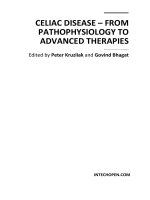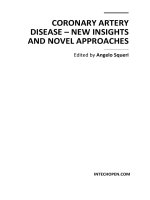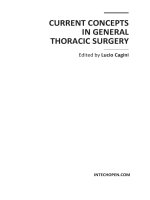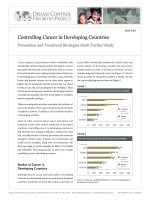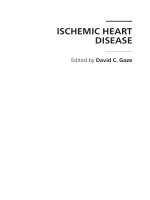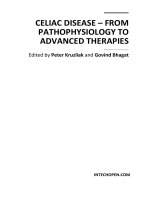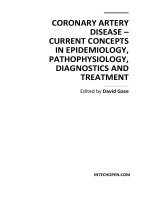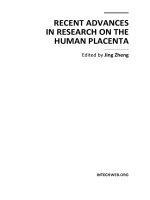Coronary Artery Disease – Current Concepts in Epidemiology, Pathophysiology, Diagnostics and Treatment Edited by David Gaze pptx
Bạn đang xem bản rút gọn của tài liệu. Xem và tải ngay bản đầy đủ của tài liệu tại đây (12.35 MB, 286 trang )
CORONARY ARTERY
DISEASE –
CURRENT CONCEPTS
IN EPIDEMIOLOGY,
PATHOPHYSIOLOGY,
DIAGNOSTICS AND
TREATMENT
Edited by David Gaze
Coronary Artery Disease – Current Concepts in Epidemiology, Pathophysiology,
Diagnostics and Treatment
Edited by David Gaze
Published by InTech
Janeza Trdine 9, 51000 Rijeka, Croatia
Copyright © 2012 InTech
All chapters are Open Access distributed under the Creative Commons Attribution 3.0
license, which allows users to download, copy and build upon published articles even for
commercial purposes, as long as the author and publisher are properly credited, which
ensures maximum dissemination and a wider impact of our publications. After this work
has been published by InTech, authors have the right to republish it, in whole or part, in
any publication of which they are the author, and to make other personal use of the
work. Any republication, referencing or personal use of the work must explicitly identify
the original source.
As for readers, this license allows users to download, copy and build upon published
chapters even for commercial purposes, as long as the author and publisher are properly
credited, which ensures maximum dissemination and a wider impact of our publications.
Notice
Statements and opinions expressed in the chapters are these of the individual contributors
and not necessarily those of the editors or publisher. No responsibility is accepted for the
accuracy of information contained in the published chapters. The publisher assumes no
responsibility for any damage or injury to persons or property arising out of the use of any
materials, instructions, methods or ideas contained in the book.
Publishing Process Manager Vedran Greblo
Technical Editor Teodora Smiljanic
Cover Designer InTech Design Team
First published March, 2012
Printed in Croatia
A free online edition of this book is available at www.intechopen.com
Additional hard copies can be obtained from
Coronary Artery Disease – Current Concepts in Epidemiology, Pathophysiology,
Diagnostics and Treatment, Edited by David Gaze
p. cm.
ISBN 978-953-51-0262-5
Contents
Preface IX
Part 1 Epidemiology and Pathophysiology
of Coronary Artery Disease 1
Chapter 1 Epidemiology of Coronary Artery Disease 3
John F. Beltrame, Rachel Dreyer and Rosanna Tavella
Chapter 2 Gender Differences in Coronary Artery Disease 31
Ryotaro Wake and Minoru Yoshiyama
Chapter 3 Coronary Flow: From Pathophysiology
to Clinical Noninvasive Evaluation 43
Francesco Bartolomucci, Francesco Cipriani and Giovanni Deluca
Chapter 4 Coronary Microvascular Dysfunction in CAD:
Consequences and Potential Therapeutic Applications 65
Alan N. Beneze, Jeffrey M. Gold and Betsy B. Dokken
Chapter 5 Coronary Artery Disease and Pregnancy 81
Titia P.E. Ruys, Mark R. Johnson and Jolien W. Roos-Hesselink
Part 2 Coronary Artery Disease Diagnostics 101
Chapter 6 Cardiovascular Biomarkers for the Detection
of Cardiovascular Disease 103
David C. Gaze
Chapter 7 Do We Need Another Look at Serum Uric Acid
in Cardiovascular Disease? Serum Uric Acid as
a Predictor of Outcomes in Acute Myocardial Infarction 123
Siniša Car and Vladimir Trkulja
Chapter 8 Stress Testing and Its Role in Coronary Artery Disease 147
Rajkumar K. Sugumaran and Indu G. Poornima
VI Contents
Chapter 9 Reassessing the Value of the Exercise
Electrocardiogram in the Diagnosis of Stable Chest Pain 171
Peter Bourdillon
Part 3 Treatment Regimens for Coronary Artery Disease 183
Chapter 10 Effectiveness and Efficiency of Drug Eluting Stents 185
José Moreu, José María Hernández, Juan M Ruiz-Nodar,
Nicolás Vázquez, Ángel Cequier,
Felipe Fernández-Vázquez and Carlos Crespo
Chapter 11 Coronary Revascularization in Diabetics:
The Background for an Optimal Choice 213
Giuseppe Tarantini and Davide Lanzellotti
Chapter 12 Diastolic Heart Failure After Cardiac Surgery 229
Ahmed A. Alsaddique, Colin F. Royse,
Mohammed A. Fouda and Alistair G. Royse
Chapter 13 Spinal Cord Stimulation for Managing
Angina from Coronary Artery Disease 257
Billy Huh
Preface
Cardiovascular disease is ranked as the leading cause of death world wide. According
to the World Heart Federation, cardiovascular disease is responsible for 17.1 million
deaths globally each year. Surprisingly, 82% of these deaths occur in the developing
world. Such numbers are often difficult to comprehend. The gravity of the situation is
enhanced when portrayed as the following: Heart disease kills one person every 34
seconds in the USA alone. 35 people under the age of 65 die prematurely in the UK
every day due to cardiovascular disease (12,500 deaths per annum). Although the
leading killer, the incidence of cardiovascular disease has declined in recent years due
to a better understanding of the pathology, implementation of lipid lowering therapy
new drug regimens including low molecular weight heparin and antiplatelet drugs
such as glycoprotein IIb/IIIa receptor inhibitors and acute surgical intervention.
The disease burden has a great financial impact on global healthcare systems and
major economic consequences for world economies. Cardiovascular disease cost the
UK healthcare system £14.4 billion (€16.7 billion; $22.8 billion) in 2006. Hospital care
for patients with cardiovascular disease accounts for approximately 70% of the cost
with 20% spent on pharmacological agents. The total cost should include non-
healthcare costs such as production losses in the workforce and informal care of
people with the disease. Production loss is estimated to cost the UK economy £8.2
billion in 2006 (55% due to death and 45% due to illness). Informal care cost the UK
economy £8.0 billion in 2006. Overall cardiovascular disease is estimated to cost the
UK economy £30.7 billion per annum.
This text aims to deliver the current understanding of coronary artery disease and is
split into three main sections:
1. Epidemiology and pathophysiology of coronary artery disease where the spectrum of the
disease will be described in relation to geographical location. Data from the
industrialised countries on rates of myocardial infarction and angina are
discussed in particular with reference to the wider healthcare and socioeconomic
status. In the second chapter gender differences in rates and type of
cardiovascular diseases are discussed. Often women view cardiovascular disease
as a lower disease category than breast or cervical cancer. The differences in
atherosclerotic pathology between men and women are discussed as well as the
X Preface
different approaches to diagnostic regimens, treatment and mortality. Coronary
blood flow is discussed with reference to the turbulence caused by atherosclerotic
lesions and the clinical importance of Doppler Echocardiography in the
evaluation of ischemic myocardium. In clinical practice, many patients present
with angina and reduced coronary flow reserve despite normal coronary
angiography of the large epicardial arteries. In this situation the vessels that limit
flow to myocardium are the more distal epicardial prearterioles and
intramyocardial arterioles typically too small to be visualized by conventional
coronary angiography. Coronary microvascular dysfunction is poorly understood
and difficult to manage. In addition, the presence of coronary microvascular
dysfunction can be a confounding factor in the management of cardiac patients
and is discussed in detail. The final chapter in this section deals with coronary
artery disease during pregnancy. The incidence of pregnancy related acute
coronary syndrome is 6 per 100,000 deliveries. One of the most important risk
factors is maternal age. Pregnancy is a hypercoagulable state and has a major
impact on hemodynamics. The presence of reduced left ventricular function
increases the chance of an adverse maternal and fetal outcome. The underlying
cause of an acute coronary syndrome may be different from outside pregnancy.
The aetiology, pathophysiology and associated mortality as well as treatment
options are discussed.
2. Coronary artery disease diagnostics. The first chapter of this section deals with the
laboratory based biomarkers used to detect coronary artery disease. The challenge
has been the identification of a cardiospecific biomarker. The cardiovascular
biomarkers essentially fall into three categories. Those that identify patients at risk
atherosclerosis; those associated with plaque destabilisation and those which
indicate rupture of the plaque, necrosis and cardiac insufficiency. The use of
serum uric acid as a predictive biomarker in myocardial infarction is discussed in
the second chapter. A plethora of non-clinical, clinical and epidemiological studies
have accumulated over the decades that aimed to elucidate molecular and cellular
mechanisms of uric acid and its role as a diagnostic and prognostic aid or
importantly, as a therapeutic target. This stems from its antioxidant potential. The
role of serum uric acid on the cardiovascular system with respect to hypertension,
stroke, renal failure, heart failure and coronary heart disease are discussed. Being
able to identify patients with coronary artery disease early will help lower
hospital costs and decrease mortality and morbidity. Stress testing has emerged as
the sole non-invasive method for risk stratifying patients. Apart from highlighting
the advantages and disadvantages of various stress testing modalities, the chapter
reviews which patients should undergo stress testing based on appropriateness
criteria; managed separately based on their risk factors and identifying those who
may be at increased risk of acute myocardial infarction or death. The final chapter
of this section discusses the role of exercise electrocardiography in patients with
stable chest pain. A UK National Institute for Health and Clinical Excellence
(NICE) guideline on the diagnosis of discomfort of suspected cardiac origin
Preface XI
published in 2010 proposes that Exercise ECG should not be used to diagnose or
exclude angina for people without known coronary artery disease Historically
exercise electrocardiography in the diagnosis of coronary artery disease has been
questioned. However, the greater the ST segment changes on exercise
electrocardiography, the greater the post-exercise probability of coronary artery
disease. The chapter demonstrates the different impact the exercise
electrocardiography has on subsequent management, depending on the method
employed to analyse the data.
3. Treatment regimens for coronary artery disease The discovery of statins over 30 years
ago comprised a revolution in the management of dyslipidaemia. Statins target
hepatocytes and inhibit 3-hydroxy-3-methylglutaryl coenzyme A (HMG-CoA)
reductase, the enzyme that converts HMG-CoA into mevalonic acid, a cholesterol
precursor. They directly inhibit cholesterol synthesis. Statins exert several
beneficial effects on patients with coronary artery disease, whether managed
conservatively or undergoing surgical or percutaneous treatment. This chapter
discusses the effects of optimal statin therapy in primary and secondary
prevention, in particular clinical settings such as; acute coronary syndrome, and in
patients undergoing percutaneous coronary intervention or coronary artery by-
pass surgery. The second chapter in this section looks at the effectiveness and
efficiency of drug eluting stents. With the use of data from stent registries in
Europe and clinical trails in the field, this chapter discusses the benefit of drug
eluting over bare metal stents with respect to restenosis rates, cardiac morbidity
and mortality and provides an economic basis for their use. The third chapter
tackles the impact of incomplete revascularisation on survival in systematic off-
pump coronary artery bypass grafting surgery. It remains unclear whether the
decreased number of grafts seen in off-pump versus on-pump bypass grafting is
owing to patient selection. Incomplete revascularisation can derive from a surgical
strategy of target vessel revascularisation in high-risk patients, where the impact
of surgery is minimised to reduce perioperative mortality and morbidity, aiming
to achieve the best feasible safe revascularisation. Revascularisation of diabetic
patients is discussed in detail in the next chapter with the aid of case studies for
illustration. Diabetes mellitus constitutes an independent predictor of early stent
thrombosis, both in bare metal and drug eluting stents. Current guidelines favor
coronary artery bypass graft surgery over percutaneous coronary intervention in
most diabetic patients with multi-vessel disease; however, substantial variability
exists in the current medical practice suggesting a lack of clinical consensus. The
penultimate chapter of this section discusses diastolic heart failure following
cardiac surgery; defining the clinical spectrum, the pathophysiology of diastole
and contributing factors. The authors describe in detail methods to assess diastolic
function. The final chapter discusses the role of spinal cord stimulation for the
management of angina from coronary artery disease. Despite the recent advances
in managing angina pectoris, many patients suffer from intractable pain. For those
patients who have already failed optimal medical and surgical therapy, very few,
XII Preface
if any, therapeutic options are available. Spinal cord stimulation may play a
unique role in managing such refractory anginal pain. This chapter details, the
mechanisms of spinal cord stimulation, methodology employed as well as clinical
outcomes.
Acknowledgements
I would like to acknowledge the tremendous efforts of the contributing authors to
these chapters. The tireless work they have provided gives insight into the world of
the basic and clinical sciences. It is their drive to continue to investigate and share their
findings that drives forward science. In essence, through their work, we hope to
provide help and treatment for the millions of people affected by coronary artery
disease around the globe. I would also like to thank Mr Vedran Greblo of InTECH
publishers for keeping the production of this book active and to for steering me to
complete the editorial review by the appropriate deadlines. Lastly I have to say thank
you to the true unsung heroes. The patients and their families who agree to participate
in research programs; the benefits of which may not necessarily help themselves but
could help their fellow humans in the future. It is these people who deserve the most
credit.
David C. Gaze
Dept of Chemical Pathology Clinical Blood Sciences,
St George’s Healthcare NHS Trust, London,
UK

